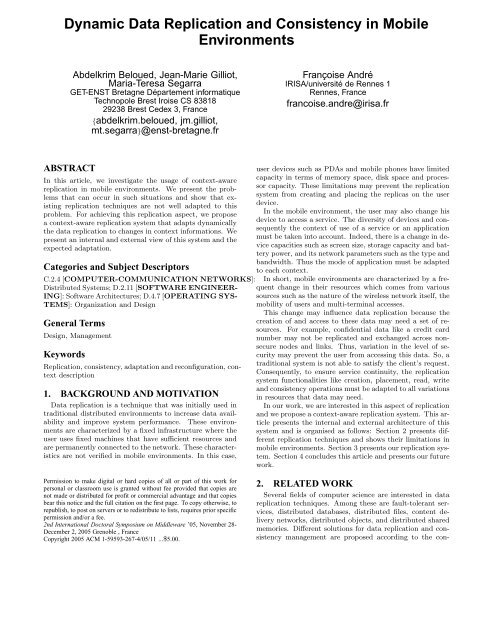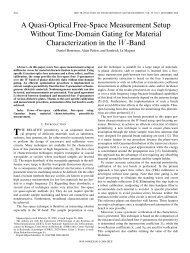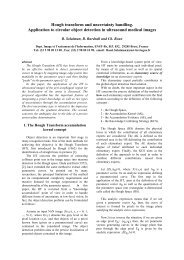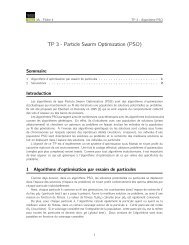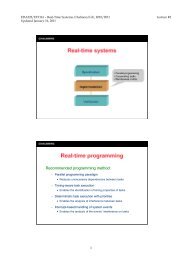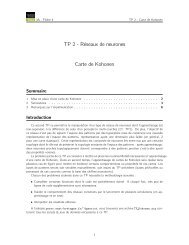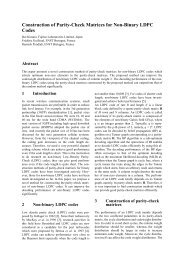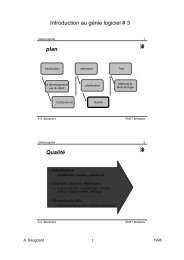Dynamic Data Replication and Consistency in Mobile Environments
Dynamic Data Replication and Consistency in Mobile Environments
Dynamic Data Replication and Consistency in Mobile Environments
You also want an ePaper? Increase the reach of your titles
YUMPU automatically turns print PDFs into web optimized ePapers that Google loves.
<strong>Dynamic</strong> <strong>Data</strong> <strong>Replication</strong> <strong>and</strong> <strong>Consistency</strong> <strong>in</strong> <strong>Mobile</strong><br />
<strong>Environments</strong><br />
Abdelkrim Beloued, Jean-Marie Gilliot,<br />
Maria-Teresa Segarra<br />
GET-ENST Bretagne Département <strong>in</strong>formatique<br />
Technopole Brest Iroise CS 83818<br />
29238 Brest Cedex 3, France<br />
{abdelkrim.beloued, jm.gilliot,<br />
mt.segarra}@enst-bretagne.fr<br />
Françoise André<br />
IRISA/université de Rennes 1<br />
Rennes, France<br />
francoise.<strong>and</strong>re@irisa.fr<br />
ABSTRACT<br />
In this article, we <strong>in</strong>vestigate the usage of context-aware<br />
replication <strong>in</strong> mobile environments. We present the problems<br />
that can occur <strong>in</strong> such situations <strong>and</strong> show that exist<strong>in</strong>g<br />
replication techniques are not well adapted to this<br />
problem. For achiev<strong>in</strong>g this replication aspect, we propose<br />
a context-aware replication system that adapts dynamically<br />
the data replication to changes <strong>in</strong> context <strong>in</strong>formations. We<br />
present an <strong>in</strong>ternal <strong>and</strong> external view of this system <strong>and</strong> the<br />
expected adaptation.<br />
Categories <strong>and</strong> Subject Descriptors<br />
C.2.4 [COMPUTER-COMMUNICATION NETWORKS]:<br />
Distributed Systems; D.2.11 [SOFTWARE ENGINEER-<br />
ING]: Software Architectures; D.4.7 [OPERATING SYS-<br />
TEMS]: Organization <strong>and</strong> Design<br />
General Terms<br />
Design, Management<br />
Keywords<br />
<strong>Replication</strong>, consistency, adaptation <strong>and</strong> reconfiguration, context<br />
description<br />
1. BACKGROUND AND MOTIVATION<br />
<strong>Data</strong> replication is a technique that was <strong>in</strong>itially used <strong>in</strong><br />
traditional distributed environments to <strong>in</strong>crease data availability<br />
<strong>and</strong> improve system performance. These environments<br />
are characterized by a fixed <strong>in</strong>frastructure where the<br />
user uses fixed mach<strong>in</strong>es that have sufficient resources <strong>and</strong><br />
are permanently connected to the network. These characteristics<br />
are not verified <strong>in</strong> mobile environments. In this case,<br />
user devices such as PDAs <strong>and</strong> mobile phones have limited<br />
capacity <strong>in</strong> terms of memory space, disk space <strong>and</strong> processor<br />
capacity. These limitations may prevent the replication<br />
system from creat<strong>in</strong>g <strong>and</strong> plac<strong>in</strong>g the replicas on the user<br />
device.<br />
In the mobile environment, the user may also change his<br />
device to access a service. The diversity of devices <strong>and</strong> consequently<br />
the context of use of a service or an application<br />
must be taken <strong>in</strong>to account. Indeed, there is a change <strong>in</strong> device<br />
capacities such as screen size, storage capacity <strong>and</strong> battery<br />
power, <strong>and</strong> its network parameters such as the type <strong>and</strong><br />
b<strong>and</strong>width. Thus the mode of application must be adapted<br />
to each context.<br />
In short, mobile environments are characterized by a frequent<br />
change <strong>in</strong> their resources which comes from various<br />
sources such as the nature of the wireless network itself, the<br />
mobility of users <strong>and</strong> multi-term<strong>in</strong>al accesses.<br />
This change may <strong>in</strong>fluence data replication because the<br />
creation of <strong>and</strong> access to these data may need a set of resources.<br />
For example, confidential data like a credit card<br />
number may not be replicated <strong>and</strong> exchanged across nonsecure<br />
nodes <strong>and</strong> l<strong>in</strong>ks. Thus, variation <strong>in</strong> the level of security<br />
may prevent the user from access<strong>in</strong>g this data. So, a<br />
traditional system is not able to satisfy the client’s request.<br />
Consequently, to ensure service cont<strong>in</strong>uity, the replication<br />
system functionalities like creation, placement, read, write<br />
<strong>and</strong> consistency operations must be adapted to all variations<br />
<strong>in</strong> resources that data may need.<br />
In our work, we are <strong>in</strong>terested <strong>in</strong> this aspect of replication<br />
<strong>and</strong> we propose a context-aware replication system. This article<br />
presents the <strong>in</strong>ternal <strong>and</strong> external architecture of this<br />
system <strong>and</strong> is organised as follows: Section 2 presents different<br />
replication techniques <strong>and</strong> shows their limitations <strong>in</strong><br />
mobile environments. Section 3 presents our replication system.<br />
Section 4 concludes this article <strong>and</strong> presents our future<br />
work.<br />
Permission to make digital or hard copies of all or part of this work for<br />
personal or classroom use is granted without fee provided that copies are<br />
not made or distributed for profit or commercial advantage <strong>and</strong> that copies<br />
bear this notice <strong>and</strong> the full citation on the first page. To copy otherwise, to<br />
republish, to post on servers or to redistribute to lists, requires prior specific<br />
permission <strong>and</strong>/or a fee.<br />
2nd International Doctoral Symposium on Middleware ’05, November 28-<br />
December 2, 2005 Grenoble , France<br />
Copyright 2005 ACM 1-59593-267-4/05/11 ...$5.00.<br />
2. RELATED WORK<br />
Several fields of computer science are <strong>in</strong>terested <strong>in</strong> data<br />
replication techniques. Among these are fault-tolerant services,<br />
distributed databases, distributed files, content delivery<br />
networks, distributed objects, <strong>and</strong> distributed shared<br />
memories. Different solutions for data replication <strong>and</strong> consistency<br />
management are proposed accord<strong>in</strong>g to the con-
stra<strong>in</strong>ts <strong>and</strong> objectives of each field.<br />
For fault-tolerant services, the appropriate system for achiev<strong>in</strong>g<br />
fault tolerance is the group communication system that<br />
is <strong>in</strong>troduced <strong>in</strong> [2](see also [3]). To ensure fault tolerance,<br />
the correctness criteria of l<strong>in</strong>earisability <strong>and</strong> sequential<br />
consistency must be satisfied. Two pr<strong>in</strong>cipal techniques<br />
are proposed <strong>in</strong> order to satisfy these constra<strong>in</strong>ts: passive<br />
replication <strong>and</strong> active replication [3] [8] [15] [18]. In passive<br />
replication, clients communicate with a primary replica<br />
that propagates update messages to other replicas. In active<br />
replication, clients communicate by multicast with all<br />
replicas. Other hybrid techniques like semi-active [9] <strong>and</strong><br />
semi-passive [4] replication comb<strong>in</strong>e the previous techniques.<br />
In the database field, the correctness criterion is one-copy<br />
serialisability [1] which means that an execution of a set of<br />
transactions on a replicated database is equivalent to a serial<br />
execution of these transactions on a non-replicated database.<br />
Several replication strategies are proposed <strong>in</strong> the literature<br />
to ensure this criterion. [7] [18] have categorised these<br />
strategies <strong>in</strong> four classes accord<strong>in</strong>g to: the update propagation<br />
approach <strong>and</strong> the update ownership approach. The<br />
propagation strategy can either be an eager propagation or a<br />
lazy propagation. In case of eager propagation, updates are<br />
applied to all replicas as part of one atomic transaction. In<br />
the lazy replication, the update messages are asynchronously<br />
propagated to other replicas after the transaction commit.<br />
The ownership strategy can be a master or a group ownership.<br />
In the former case, updates are first applied to the<br />
primary copy <strong>and</strong> then to other copies. In the latter case,<br />
any copy can update other replicas. Consequently, we can<br />
dist<strong>in</strong>guish four classes of replication strategies: eager group<br />
replication, eager master replication, lazy group replication,<br />
<strong>and</strong> lazy master replication.<br />
Some exist<strong>in</strong>g systems try to ensure a high data availability<br />
like Bayou <strong>and</strong> Coda, but these systems establish a weak<br />
data consistency. Bayou [5] is a mobile database replication<br />
platform on which developers can build collaborative<br />
applications. Bayou adopts a flexible replication strategy<br />
(read any/write any) that allows a user to access the data<br />
from any node. An anti-entropy protocol is used for update<br />
propagation between weakly consistent replicas. This<br />
protocol is based on pair-wise communication. Bayou allows<br />
the detection <strong>and</strong> the resolution of update conflicts <strong>in</strong><br />
an application-specific manner. In order to do this, dependency<br />
checks <strong>and</strong> merge procedures are used. Coda [12] [3]<br />
is a file system that replicates each file on a group of servers<br />
<strong>and</strong> manages the network disconnection. This allows a mobile<br />
user to work <strong>in</strong> disconnected mode by access<strong>in</strong>g a local<br />
cache. The replication strategy that is used <strong>in</strong> Coda is a<br />
variant of a read-one/write-all approach. Coda also allows<br />
the detection <strong>and</strong> the resolution of update conflicts by means<br />
of Coda version vector (CVV) <strong>and</strong> Coda repair tool.<br />
Some previous works on replication consider some environment<br />
parameters that are related to the system performance<br />
which may <strong>in</strong>deed be <strong>in</strong>fluenced by the change <strong>in</strong><br />
mobile environment resources. For example, the b<strong>and</strong>width<br />
degradation <strong>and</strong> the change <strong>in</strong> user location can considerably<br />
<strong>in</strong>crease the response time <strong>and</strong> the network overhead.<br />
Among these studies are [11] [10] that take <strong>in</strong>to account, at<br />
replica placement time, network topology <strong>in</strong>formation <strong>and</strong><br />
user location <strong>in</strong> order to reduce the client access latency<br />
<strong>and</strong> the network overhead. [19] propose a dynamic replication<br />
scheme which is based on users’ mobility schedules,<br />
access behavior <strong>and</strong> read/write patterns. [16] propose a<br />
generalized framework for replica host<strong>in</strong>g system that automatically<br />
adapts the replication scheme to variations <strong>in</strong><br />
some parameters which are related to the system performance<br />
<strong>and</strong> are classified as controllable <strong>and</strong> uncontrollable<br />
parameters. Controllable parameters are those whose value<br />
can be controlled by the system e.g, the number of replicas<br />
<strong>and</strong> their location. Uncontrollable parameters are those<br />
which cannot be directly controlled by the system like client<br />
request rates <strong>and</strong> update rates for Web documents. [17]<br />
propose replica creation <strong>in</strong> mobile devices to allow the operation<br />
<strong>in</strong> disconnected mode <strong>and</strong>/or to avoid the use of weak<br />
b<strong>and</strong>width l<strong>in</strong>ks.<br />
However, these works do not take <strong>in</strong>to account the nature<br />
of data. Indeed, accord<strong>in</strong>g to its nature, data may need a set<br />
of resources such as network b<strong>and</strong>width <strong>and</strong> storage space<br />
<strong>in</strong> order to be replicated. Other environment <strong>in</strong>formation<br />
like node security, device type <strong>and</strong> user activity may also<br />
be essential for replicat<strong>in</strong>g or perform<strong>in</strong>g any operation on<br />
this data. For example, for the bank<strong>in</strong>g application, data is<br />
confidential. That is, to create <strong>and</strong> place this data, we need<br />
a high security level for nodes <strong>and</strong> l<strong>in</strong>ks. The change <strong>in</strong> some<br />
of this <strong>in</strong>formation might not <strong>in</strong>fluence the performance of<br />
the system <strong>and</strong> the previous works cannot therefore provide<br />
a satisfy<strong>in</strong>g solution to replication.<br />
This limited context <strong>in</strong>formation management has motivated<br />
us to study this replication aspect. Thus, we propose a<br />
context-aware replication system, the architecture of which<br />
is presented <strong>in</strong> the follow<strong>in</strong>g section.<br />
3. EXPECTED CONTRIBUTION<br />
3.1 Execution context<br />
There are many def<strong>in</strong>itions of context. Among them,<br />
Schilit et al. [13] consider three important aspects of context:<br />
where you are, who you are with, <strong>and</strong> what resources are<br />
nearby. Context can thus <strong>in</strong>clude light<strong>in</strong>g, network connectivity,<br />
communication b<strong>and</strong>width, etc. Dey et al. [6] def<strong>in</strong>e<br />
the context as any <strong>in</strong>formation that can be used to characterise<br />
the situation of an entity. An entity is a person,<br />
place, or object that is considered relevant to the <strong>in</strong>teraction<br />
between a user <strong>and</strong> an application, <strong>in</strong>clud<strong>in</strong>g the user <strong>and</strong><br />
application themselves.<br />
Context <strong>in</strong>formation is first sensed by sensors. Next, it<br />
is h<strong>and</strong>led by a context-aware <strong>in</strong>frastructure [14] [6] that<br />
provides a high-level context <strong>in</strong>formation to an application.<br />
All of these steps are outside the scope of this paper.<br />
In our work, we need two types of context: required context<br />
<strong>and</strong> provided context.<br />
The required context consists of data constra<strong>in</strong>ts <strong>and</strong> user<br />
preferences. Accord<strong>in</strong>g to its nature, data may need a set of<br />
resources like storage space <strong>and</strong> b<strong>and</strong>width. So, the application<br />
designer def<strong>in</strong>es a set of constra<strong>in</strong>ts that have to be<br />
satisfied <strong>in</strong> order to create data replicas or perform any operation<br />
on these replicas such as read/write operations <strong>and</strong><br />
consistency.<br />
The provided context consists of all software properties<br />
such as the operat<strong>in</strong>g system <strong>and</strong> programm<strong>in</strong>g language,<br />
hardware properties like available processors <strong>and</strong> storage<br />
space, <strong>and</strong> physical environment properties like meet<strong>in</strong>g room<br />
state. This type of context may also <strong>in</strong>clude the user profile,<br />
like his location <strong>and</strong> daily activities.<br />
Our replication system takes <strong>in</strong>to account this <strong>in</strong>formation
<strong>and</strong> adapts a replication scheme to it.<br />
3.2 Internal view of our replication system<br />
The pr<strong>in</strong>cipal functionalities of a replication system are:<br />
replica creation, replica placement, read/write operation <strong>and</strong><br />
replica consistency. Consequently, our system conta<strong>in</strong>s three<br />
pr<strong>in</strong>cipal modules: a replica planner, a localisation manager<br />
<strong>and</strong> a consistency manager as shown <strong>in</strong> Figure 1.<br />
The replica planner is responsible for the creation <strong>and</strong><br />
placement of replicas on nodes. Next, the localisation manager<br />
locates replicas for read/write operations <strong>and</strong> then performs<br />
these operations. F<strong>in</strong>ally, the consistency manager<br />
ensures replica consistency by exchang<strong>in</strong>g update messages<br />
after each write operation <strong>and</strong> resolv<strong>in</strong>g update conflicts.<br />
The other modules <strong>and</strong> the system functionality will be<br />
presented progressively <strong>in</strong> the follow<strong>in</strong>g sections.<br />
Figure 1: Internal view of our replication system<br />
Our replication system takes <strong>in</strong>to account the execution<br />
context <strong>and</strong> adapts its functionalities to changes <strong>in</strong> this context.<br />
We consider three dimensions of adaptation accord<strong>in</strong>g<br />
to the adaptation trigger (adaptation to context variations,<br />
adaptation to system state variations), the adaptation<br />
moment (adaptation at the application deployment<br />
time i.e, configuration, adaptation at the application run<br />
time i.e, reconfiguration), <strong>and</strong> the adaptation object (replication<br />
scheme adaptation, replication strategy adaptation).<br />
Thus, we have to deal with the replication scheme <strong>and</strong><br />
replication strategy configuration <strong>and</strong> reconfiguration as shown<br />
<strong>in</strong> Table 1.<br />
<strong>Replication</strong><br />
scheme<br />
<strong>Replication</strong><br />
strategy<br />
Configuration<br />
<strong>Replication</strong><br />
scheme configuration<br />
<strong>Replication</strong><br />
strategy configuration<br />
Table 1: Adaptation classes<br />
Reconfiguration<br />
<strong>Replication</strong><br />
scheme reconfiguration<br />
<strong>Replication</strong><br />
strategy reconfiguration<br />
3.2.1 <strong>Replication</strong> scheme configuration<br />
The replication scheme is represented by three plans: a<br />
placement plan, a localisation plan <strong>and</strong> a consistency plan.<br />
These plans are provided by the replica planner, the localisation<br />
manager <strong>and</strong> the consistency manager respectively.<br />
The placement plan <strong>in</strong>dicates the placement of each replica<br />
on nodes. Next, the localisation plan <strong>in</strong>dicates for each user<br />
a set of nodes <strong>and</strong> l<strong>in</strong>ks where he can reach each replica.<br />
F<strong>in</strong>ally, the consistency plan <strong>in</strong>dicates for each replica a set<br />
of nodes <strong>and</strong> l<strong>in</strong>ks where an update can be propagated from<br />
this replica to other replicas.<br />
The replication scheme is provided at the application deployment<br />
time accord<strong>in</strong>g to the current context <strong>and</strong> the current<br />
system state. This replication scheme is then stored<br />
<strong>in</strong> the history. The placement plan is immediately projected<br />
onto the environment. The localisation <strong>and</strong> consistency<br />
plans are used at the read/write time.<br />
3.2.2 <strong>Replication</strong> scheme reconfiguration<br />
In order to monitor the execution context <strong>and</strong> the system<br />
state, we propose adaptation trigger modules (Application<br />
Interface, Context Analyser, <strong>and</strong> System State Monitor).<br />
The application <strong>in</strong>terface <strong>and</strong> the context analyser detect<br />
the pert<strong>in</strong>ent change <strong>in</strong> required context <strong>in</strong>formation <strong>and</strong><br />
provided context <strong>in</strong>formation respectively. Next, they store<br />
this change <strong>in</strong> the required context repository <strong>and</strong> the provided<br />
context repository. F<strong>in</strong>ally, they notify different modules<br />
(replica planner, localisation manager <strong>and</strong> consistency<br />
manager) of this change. These latter provide a replication<br />
scheme that is most adapted to the change <strong>in</strong> context by<br />
modify<strong>in</strong>g their correspond<strong>in</strong>g plans that are stored <strong>in</strong> the<br />
history. For example, if the b<strong>and</strong>width is decreased, the system<br />
changes some replica locations <strong>in</strong> order to avoid the use<br />
of weak b<strong>and</strong>width l<strong>in</strong>ks.<br />
The basic objective of the replication technique is to improve<br />
the performance <strong>and</strong> to <strong>in</strong>crease the data availability<br />
<strong>and</strong> consistency. To reach these objectives, our replication<br />
system monitors its own state. This state is represented by<br />
system performance parameters, data availability parameters,<br />
<strong>and</strong> data consistency parameters. For example, the<br />
response time is a parameter characteriz<strong>in</strong>g the system performance.<br />
Each parameter is measured by a metric. Different<br />
parameters are evaluated by the system <strong>and</strong> stored<br />
<strong>in</strong> the history. The system state monitor detects the pert<strong>in</strong>ent<br />
change <strong>in</strong> these parameters <strong>and</strong> notifies the replica<br />
planner, localisation manager <strong>and</strong> consistency manager of<br />
this change. These modules modify the replication scheme<br />
<strong>in</strong> order to redress the system state. For example, if the<br />
response time <strong>in</strong>creases, the replica planner modifies some<br />
replica locations <strong>in</strong> order to reduce this parameter.<br />
3.2.3 <strong>Replication</strong> strategy configuration<br />
Our replication system adapts the replication strategy to<br />
context or system state variations. For example, the system<br />
changes its strategy from a pessimistic strategy to an optimistic<br />
one <strong>in</strong> order to improve the data availability. This<br />
adaptation is based on a set of rules that specify the strategy<br />
application conditions. To manage this adaptation, we<br />
propose a strategy manager that ensures system consistency<br />
<strong>and</strong> implements a new strategy.<br />
The strategy configuration is carried out at the application<br />
deployment time. Based on the current context <strong>and</strong> the<br />
current system state, the strategy manager chooses the most<br />
adapted replication strategy <strong>and</strong> implements it <strong>in</strong> the replica<br />
planner, localisation manager, <strong>and</strong> consistency manager.<br />
3.2.4 <strong>Replication</strong> strategy reconfiguration
The replication strategy reconfiguration is carried out at<br />
application run time. After receiv<strong>in</strong>g the notification from<br />
the adaptation trigger modules, the strategy manager chooses<br />
the adapted strategy, ensures the system consistency <strong>and</strong><br />
implements this strategy <strong>in</strong> some or all modules (replica<br />
planner, localisation manager, <strong>and</strong> consistency manager).<br />
3.2.5 Adaptation Process<br />
To summarize, at the application deployment time, the<br />
current context <strong>and</strong> system state are analysed by adaptation<br />
trigger modules. Based on this analysis, the strategy<br />
manager chooses the most adapted replication strategy <strong>and</strong><br />
implements it <strong>in</strong> the replica planner, localisation manager,<br />
<strong>and</strong> consistency manager. Then these modules provide a<br />
replication scheme that is adapted to this context as shown<br />
<strong>in</strong> Figure 2.<br />
Figure 2: Adaptation process<br />
At the application run time, adaptation trigger modules<br />
monitor context <strong>in</strong>formation <strong>and</strong> system state parameters<br />
<strong>and</strong> detect the pert<strong>in</strong>ent change <strong>in</strong> this <strong>in</strong>formation. If this<br />
change is pert<strong>in</strong>ent for a replication strategy then these modules<br />
notify the strategy manager.Otherwise, if it is pert<strong>in</strong>ent<br />
for data then trigger modules notify the replicas planner, localisation<br />
manager <strong>and</strong> consistency manager. In the former<br />
case, the strategy manager chooses the replication strategy<br />
that is adapted to new <strong>in</strong>formation <strong>and</strong> ensures the system<br />
consistency. In the latter case, the replica planner, localisation<br />
manager <strong>and</strong> consistency manager modify their plans<br />
that are stored <strong>in</strong> the history.<br />
3.3 External view of our replication system<br />
Our replication system <strong>in</strong>teracts with the application <strong>in</strong><br />
order to communicate data to be replicated <strong>and</strong> their resource<br />
constra<strong>in</strong>ts as shown <strong>in</strong> Figure 3. It also <strong>in</strong>teracts<br />
with the execution environment <strong>in</strong> order to collect its resources<br />
<strong>and</strong> to project the replication scheme onto this environment.<br />
Figure 3: External view of the replication system<br />
These <strong>in</strong>teractions are carried out accord<strong>in</strong>g to a set of<br />
formats (meta-models) that are def<strong>in</strong>ed by the system designer.<br />
First, the application designer must def<strong>in</strong>e <strong>and</strong> describe<br />
the data to be replicated. This description allows the application<br />
to treat the data <strong>and</strong> to communicate them to the<br />
replication system. This latter can be based on a st<strong>and</strong>ard<br />
data format like object <strong>and</strong> component data, or a specific<br />
format that describes the data structure.<br />
The application designer must also describe the data constra<strong>in</strong>ts<br />
before communicat<strong>in</strong>g them to the replication system.<br />
This description is carried out accord<strong>in</strong>g to a well<br />
def<strong>in</strong>ed format that specifies the manner <strong>in</strong> which different<br />
replication system modules can underst<strong>and</strong> data constra<strong>in</strong>t<br />
semantics. This format is def<strong>in</strong>ed by the system designer<br />
<strong>and</strong> represents a meta-model for the required context description.<br />
Provided context <strong>in</strong>formation must also be described <strong>in</strong><br />
order to exchange <strong>and</strong> analyse them. This description is<br />
based on a meta-model for the provided context description.<br />
<strong>Replication</strong> strategies <strong>and</strong> their correspond<strong>in</strong>g rules have<br />
to be described <strong>in</strong> order to adapt them to execution context<br />
<strong>and</strong> system state variations.<br />
F<strong>in</strong>ally, the replication scheme also has to be described <strong>in</strong><br />
order to apply the replication strategy that is based on this<br />
scheme.<br />
4. FUTURE WORK AND CONCLUDING RE-<br />
MARKS<br />
We have presented <strong>in</strong> this article the architecture of our<br />
replication system. This architecture comprises of four pr<strong>in</strong>cipal<br />
components for adapt<strong>in</strong>g data replication <strong>and</strong> consistency<br />
to the context: for adapt<strong>in</strong>g the replication strategy,<br />
the replica placement, read/write operations, <strong>and</strong> the data<br />
consistency. Each component is based on context <strong>in</strong>formation<br />
<strong>and</strong> system state parameters <strong>in</strong> order to choose the<br />
replication strategy or generate the correspond<strong>in</strong>g plan. In<br />
this paper, we have identified the necessary meta-models to<br />
carry out the different <strong>in</strong>teractions of our system: the metamodel<br />
for the description of data, strategy <strong>and</strong> context. We<br />
have also identified necessary adaptation classes. Our replication<br />
system allows the adaptation <strong>and</strong> the reconfiguration<br />
of the replication scheme <strong>and</strong> strategy.<br />
Our future work <strong>in</strong>volves <strong>in</strong> def<strong>in</strong><strong>in</strong>g each element mentioned<br />
above. That is, we have to def<strong>in</strong>e each meta-model,<br />
system module <strong>and</strong> adaptation approach.
5. REFERENCES<br />
[1] P. Bernste<strong>in</strong>, V. Hadzilacos, <strong>and</strong> N. Goodman.<br />
Concurrency Control <strong>and</strong> Recovery <strong>in</strong> <strong>Data</strong>base<br />
Systems. Addison-Wesley, 1987.<br />
[2] K. P. Birman. The process group approach to reliable<br />
distributed comput<strong>in</strong>g. Commun. ACM, 36(12):37–53,<br />
1993.<br />
[3] G. Coulouris, J. Dollimore, <strong>and</strong> T. K<strong>in</strong>dberg.<br />
Distributed systems : concepts <strong>and</strong> design. Pearson<br />
Education, third edition, 2001.<br />
[4] X. Défago, A. Schiper, <strong>and</strong> N. Sergent. Semi-passive<br />
replication. In SRDS ’98: Proceed<strong>in</strong>gs of the The 17th<br />
IEEE Symposium on Reliable Distributed Systems,<br />
pages 43–50, Wash<strong>in</strong>gton, DC, USA, 1998. IEEE<br />
Computer Society.<br />
[5] A. J. Demers, K. Petersen, M. J. Spreitzer, D. B.<br />
Terry, M. M. Theimer, <strong>and</strong> B. B. Welch. The bayou<br />
architecture: Support for data shar<strong>in</strong>g among mobile<br />
users. In Proceed<strong>in</strong>gs IEEE Workshop on <strong>Mobile</strong><br />
Comput<strong>in</strong>g Systems <strong>and</strong> Applications, pages 2–7, 1994.<br />
[6] A. K. Dey <strong>and</strong> G. D. Abowd. Towards a better<br />
underst<strong>and</strong><strong>in</strong>g of context <strong>and</strong> context-awareness. In<br />
Workshop on the What, Who, Where, When, Why <strong>and</strong><br />
How of Context-Awareness (CHI 2000), April 2000.<br />
[7] J. Gray, P. Hell<strong>and</strong>, P. O’Neil, <strong>and</strong> D. Shasha. The<br />
dangers of replication <strong>and</strong> a solution. In SIGMOD ’96:<br />
Proceed<strong>in</strong>gs of the 1996 ACM SIGMOD <strong>in</strong>ternational<br />
conference on Management of data, pages 173–182,<br />
New York, NY, USA, 1996. ACM Press.<br />
[8] R. Guerraoui <strong>and</strong> A. Schiper. Software-based<br />
replication for fault tolerance. IEEE Computer,<br />
30(4):68–74, April 1997.<br />
[9] D. Powell, M. Chéréque, <strong>and</strong> D. Drackley.<br />
Fault-tolerance <strong>in</strong> delta-4*. SIGOPS Operat<strong>in</strong>g<br />
Systems Review, 25(2):122–125, 1991.<br />
[10] M. Rab<strong>in</strong>ovich, I. Rab<strong>in</strong>ovich, R. Rajaraman, <strong>and</strong><br />
A. Aggarwal. A dynamic object replication <strong>and</strong><br />
migration protocol for an <strong>in</strong>ternet host<strong>in</strong>g service. In<br />
Proc. of the IEEE International Conference on<br />
Distributed Comput<strong>in</strong>g Systems, pages 101–113, 1999.<br />
[11] P. Radoslavov, R. Gov<strong>in</strong>dan, <strong>and</strong> D. Estr<strong>in</strong>.<br />
Topology-<strong>in</strong>formed <strong>in</strong>ternet replica placement. In<br />
Proceed<strong>in</strong>gs of the Sixth International Workshop on<br />
Web Cach<strong>in</strong>g <strong>and</strong> Content Distribution, Boston, MA,<br />
2001.<br />
[12] M. Satyanarayanan, J. J. Kistler, P. Kumar, M. E.<br />
Okasaki, E. H. Siegel, <strong>and</strong> D. C. Steere. Coda: A<br />
highly available file system for a distributed<br />
workstation environment. IEEE Trans. Comput.,<br />
39(4):447–459, 1990.<br />
[13] B. N. Schilit, N. I. Adams, <strong>and</strong> R. Want.<br />
Context-aware comput<strong>in</strong>g applications. In the<br />
Workshop on <strong>Mobile</strong> Comput<strong>in</strong>g Systems <strong>and</strong><br />
Applications, pages 85–90. IEEE Computer Society,<br />
December 1994.<br />
[14] A. Schmidt, K. A. Aidoo, A. Takaluoma, U. Tuomela,<br />
K. V. Laerhoven, <strong>and</strong> W. V. de Velde. Advanced<br />
<strong>in</strong>teraction <strong>in</strong> context. In HUC ’99: Proceed<strong>in</strong>gs of the<br />
1st <strong>in</strong>ternational symposium on H<strong>and</strong>held <strong>and</strong><br />
Ubiquitous Comput<strong>in</strong>g, pages 89–101, London, UK,<br />
1999. Spr<strong>in</strong>ger-Verlag.<br />
[15] F. B. Schneider. Implement<strong>in</strong>g fault-tolerant services<br />
us<strong>in</strong>g the state mach<strong>in</strong>e approach: a tutorial. ACM<br />
Comput. Surv., 22(4):299–319, 1990.<br />
[16] S. Sivasubramanian, M. Szymaniak, G. Pierre, <strong>and</strong><br />
M. V. Steen. <strong>Replication</strong> for web host<strong>in</strong>g systems.<br />
ACM Comput. Surv., 36(3):291–334, 2004.<br />
[17] M. T.Segarra <strong>and</strong> F.André. Mfs: a mobile file system<br />
us<strong>in</strong>g generic system services. In SAC ’99: Proceed<strong>in</strong>gs<br />
of the 1999 ACM symposium on Applied comput<strong>in</strong>g,<br />
pages 419–420, New York, NY, USA, 1999. ACM<br />
Press.<br />
[18] M. Wiesmann, F. Pedone, A. Schiper, B. Kemme, <strong>and</strong><br />
G.Alonso. Underst<strong>and</strong><strong>in</strong>g replication <strong>in</strong> databases <strong>and</strong><br />
distributed systems. In Proceed<strong>in</strong>gs of 20th IEEE<br />
International Conference on Distributed Comput<strong>in</strong>g<br />
Systems (ICDCS’2000), pages 264–274. IEEE<br />
Computer Society, April 2000.<br />
[19] S. Wu <strong>and</strong> Y. Chang. An active replication scheme for<br />
mobile data management. In Proceed<strong>in</strong>gs of the Sixth<br />
International Conference on <strong>Data</strong>base Systems for<br />
Advanced Applications (DASFAA’99), pages 143–150.<br />
IEEE Computer Society, 1999.


